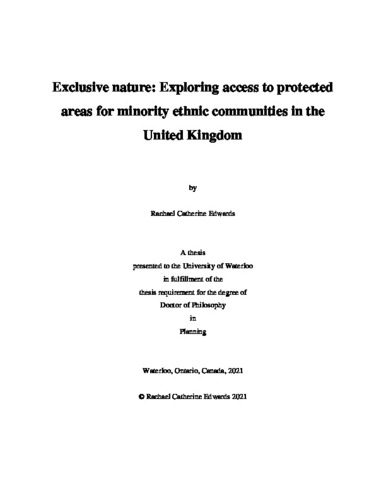| dc.description.abstract | Protected areas (PAs) provide a wide range of benefits to visitors engaged in outdoor recreation. However, several groups are underrepresented within these natural spaces including minority ethnic communities. This inequitable distribution of benefits presents an environmental injustice. In response, a large body of work has sought to explain ethnic variation in green space use patterns. Broadly, this research suggests that the barriers contributing to minority ethnic underrepresentation in green space relate to socio-economic inequality, outdoor recreation preferences, and discrimination.
Despite the growing literature on ethnicity and participation in outdoor recreation, the contribution of institutionalized factors to PA access barriers remains underexplored. To address this literature gap, the aim of this dissertation is to advance our understanding of the relationship between PA governance in the UK and access for minority ethnic communities. The UK was chosen as the context for this research given the national priority that the country has assigned to improving equity in access to nature. The dissertation is structured as a series of three articles intended for publication (an article-format thesis) that are all guided by an overarching research question: Are access considerations within the PA management planning process aligned with the access barriers experienced by minority ethnic communities? I adopted a constructivist paradigm for this thesis and, therefore, used primarily qualitative research methods.
I first explored PA access through a governance lens with the objective of identifying how user diversity is accounted for within outdoor recreation planning and programming for UK PAs (Chapter 2). This article involved a document analysis of PA management plans and a survey of PA managers. This analysis included approximately one quarter of PAs with land-based designations in the UK. Although PA managers held clear concerns about the underrepresentation of several groups, diversity and inclusion objectives were seldom emphasized within management plans. Furthermore, PA organizations did not widely recognize socio-cultural access barriers, seldom targeted minority ethnic groups, and rarely placed purposeful emphasis on the delivery of social benefits.
In my second article I explored ethnic variation in outdoor recreational preferences and the related experience of Cultural Ecosystem Benefits (Chapter 3). I conducted one hundred in-situ semi-structured interviews with urban green space users in London, UK. My results suggest that the primary Cultural Ecosystem Benefits derived from nature are similar across ethnically diverse green space users having divergent preferences. Across participants, peace and relaxation was a primary benefit derived from nature.
Finally, the objective of my third article was to identify the socio-cultural barriers and opportunities that contribute to the accessibility of PAs for Muslim communities in the UK (Chapter 4). I conducted fourteen in-depth interviews with leaders from Muslim communities, finding that a wide variety of factors inhibit access, cumulatively resulting in several layers of exclusion. Primary barriers included a lack of inclusive imagery, insufficient facilities for social gathering, prior instances of discrimination, the perceived whiteness of PAs, and unfamiliarity.
Collectively, my findings reveal several gaps within the PA management planning process that cumulatively result in a failure to adequately address the needs, experiences, and values of minority ethnic communities. These disparities are underpinned by an Anglo-normative conceptualization of the human-nature relationship, or white environmentalism, that is embedded within the PA governance. I contend that to holistically address access barriers experienced by minority ethnic communities in the UK, PA organizations must diversify to embrace alternative worldviews relating to the human-nature relationship. For this change to occur, bottom-up, participatory approaches must be more widely adopted. | en |

